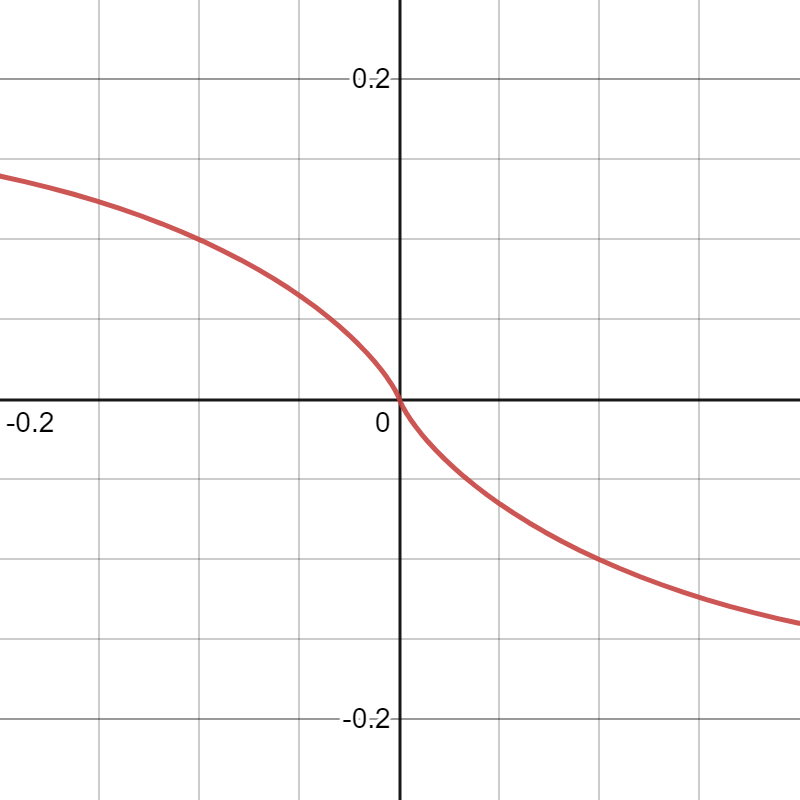Is it possible for a point-like system to behave like $x(t) = \frac{t}{2}\log(t^2)$ near $t=0$? (infinite speed)
I know beforehand that relativity theory forbids anything with mass from travel faster than speedlight, so please stay with reading the full question first before answer - is more a conceptual/mathematical issue.
For generality issues, I will work with dimensionless units (is explained later).
This question is a modification of a previous one already closed and deleted (at least I tried to, but the system didn't allow it), because of a misused of the term "particle" to explain a point-like system described on time as a scalar variable, and I still don´t know the precise technical terminology, so I hope you get the idea. Apologizes in advance to everyone for any inconvenience caused.
Imagine a point-like system which position in time is described by the equation:
$$x(t)=\frac{t}{2}\log(t^2)$$
and the point starts moving at time $t_0=-0.2$ with initial speed and the experiments ends measuring its position at time $t_f=0.2$ following the equation $x(t)$.

From the plot it look like something quite feasible to be done, but if I focus on their derivative I will note that there is a point in space where it maximum speed will rise to infinity without any discontinuity on the position of the point-like element: $$\frac{d}{dt}x(t) = 1+\frac{\log(t^2)}{2}$$
Since the maximum speed diverges $\lim\limits_{t\to 0}\|\dot{x}(t)\|_\infty \to \infty$, near zero is a neighborhood where the variable is "softly/continuously" (but not smoothly) achieving speeds that could be higher than the speed of light, but it never "teleport" since the function is continuous and is only singular in a zero-measure point of time (even, $\int\limits_{-0.2}^{0.2} |\dot{x}|^2\,dt < \infty$ and $\int\limits_{-0.2}^{0.2} |\dot{x}|\,dt < \infty$).
So, I am looking for examples of alike systems, if there are any, that could behave likewise $x(t)$ (on the Motivation I extend on which kind of systems I believe could be candidates).
- Is this kind of system attainable under current interpretation of physics laws?
- Where I am messing up with the concept of speed and its divergence?
- If this is an achievable system, Do you know a mechanic system that behaves like this?
- If no mechanical system is possible, Any other kind of physical model where some variable behaves as reaching infinite speed continuously in finite time?
Motivation
I would like to made an explanation of why this question is interesting in my opinion:
In this video I found by accident on youtube, Terence Tao, one of the most important nowadays mathematician, is reviewing finite-time blow up solutions to differential equations. There, he talk about the possibility of having this kind of solutions which reaches infinity in finite time for the Navier-Stokes equation, which is indeed a widely known physical system.
Thinking in the speed limits rise by Relativity Theory due to Einstein, I was wondering if this talk is just a mathematical curiosity which cannot be happening in real life, but then I saw this video about the Euler´s disk toy, where, for the wobbling rate the solutions indeed shows to have a finite time blow up for a inertial system (it just a frequency ratio so inertia restrictions indeed are not applying).
On this question, also I figure out that sometimes a finite time blow up system could be thought as the reciprocal of a solution of finite duration to a differential equation (meaning here, it achieves zero by it own dynamics and stays there forever after - some examples of finite duration solutions here, here, and and here).
So if some people are researching this kind of things, I was thinking that maybe something that achieving the blow up behavior in their speed profile could also be possible (at least is possible in the math).... this is why I keep unitless/dimensionless the differential equations, since maybe a model where inertia is not involved could fit the presented situation.
Another examples, the point-like system could be the displacement of a shadow, or the geometric point where scissors close as the example shown on this video. With this, inertia is not needed to be involved in the point-like system, but as the example of the Euler's Disk toy, the system could indeed be a realizable experiment with a variable showing a finite time blow up behavior (I don´t know if, maybe, by integration of this wobbling rate I could found a variable which do the trick).
